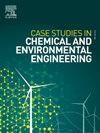土地特征及侵蚀对加约阿拉比卡咖啡生产的影响分析
Q1 Environmental Science
Case Studies in Chemical and Environmental Engineering
Pub Date : 2025-07-08
DOI:10.1016/j.cscee.2025.101258
引用次数: 0
摘要
土地特征和侵蚀是阿拉比卡咖啡产量的关键决定因素,直接影响土壤质量、土地适宜性和长期可持续性。土地特征,包括土壤的物理和化学性质,决定了土地的适宜性,而侵蚀则导致土地退化,最终降低生产力。本研究调查了土地特征和侵蚀对贝纳梅里亚摄政加约高地阿拉比卡咖啡产量的影响。实地调查和实验室土壤分析使用定量描述方法在15个定义的土地单元类型(LUTs)中进行,并使用通用土壤流失方程(USLE)估计侵蚀率。利用多元线性回归分析了土地特征和侵蚀对咖啡生产的影响。结果表明,研究区土地适宜性分为S2级(中度适宜)和S3级(轻度适宜)。重要的产量限制包括低磷有效性、有限的土壤深度、陡峭的坡度和不充分的排水。影响产量的统计显著变量(p <;0.05)包括海拔、坡度、土壤深度、粉土和粘土含量、pH、有机碳、阳离子交换量、有效磷和侵蚀速率。这些发现强调了综合土地管理在不同农业生态条件下优化阿拉比卡咖啡生产中的关键作用。本文章由计算机程序翻译,如有差异,请以英文原文为准。
Analysis of land characteristics and erosion impact on Gayo Arabica coffee production
Land characteristics and erosion are key determinants of Arabica coffee productivity, directly affecting soil quality, land suitability, and long-term sustainability. Land characteristics, including physical and chemical soil properties, determine land suitability, while erosion contributes to land degradation, ultimately reducing productivity. This study investigates the effects of land characteristics and erosion on Arabica coffee yields in the Gayo highlands of Bener Meriah Regency. Field surveys and laboratory soil analyses were conducted using a quantitative descriptive approach across 15 defined land unit types (LUTs), and erosion rates were estimated using the Universal Soil Loss Equation (USLE). Multiple linear regression analysis has been used to analyze the effect of land characteristics and erosion on coffee production. Results revealed that land suitability in the study area falls into two classes: S2 (moderately suitable) and S3 (marginally suitable). Significant yield constraints include low phosphorus availability, limited adequate soil depth, steep slope gradients, and inadequate drainage. Statistically significant variables influencing yield (p < 0.05) included elevation, slope, adequate soil depth, silt and clay percentages, pH, organic carbon, Cation Exchange Capacity, available phosphorus, and erosion rate. These findings highlight the critical role of integrated land management in optimizing Arabica coffee production under varying agroecological conditions.
求助全文
通过发布文献求助,成功后即可免费获取论文全文。
去求助
来源期刊

Case Studies in Chemical and Environmental Engineering
Engineering-Engineering (miscellaneous)
CiteScore
9.20
自引率
0.00%
发文量
103
审稿时长
40 days
 求助内容:
求助内容: 应助结果提醒方式:
应助结果提醒方式:


